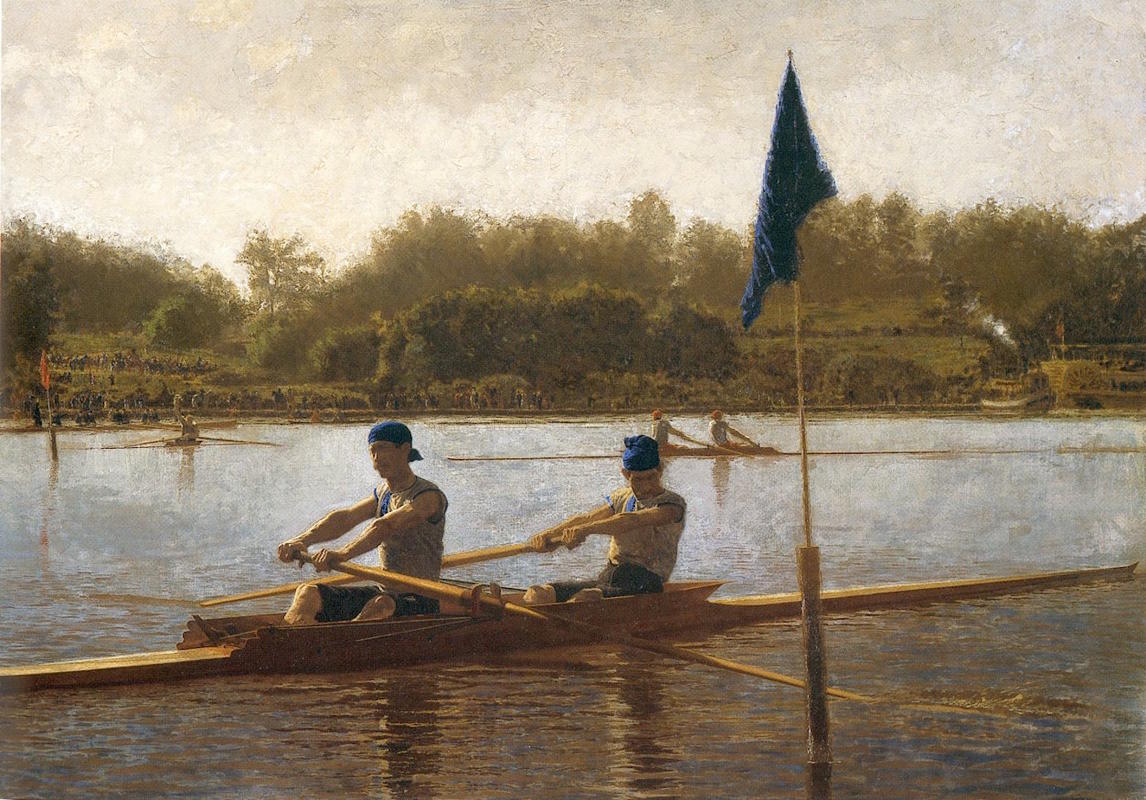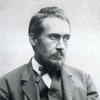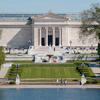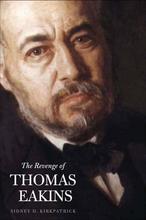More about The Biglin Brothers Turning the Stake
- All
- Info
- Shop

Sr. Contributor
For the Biglin brothers and Thomas Eakins, bros who row together help artists grow together.
Athleticism in art is nothing new. Some of the most well-known sculptures dating back to Ancient Greece glorified the tight bods of Olympic athletes. From the overly-toned hunks in the works of William-Adolphe Bougeareau to the plump people of Fernando Botero, the tradition of depicting the human form has since transformed to include a wide range of body types. As a realist painter, Eakins painted scenes from everyday life in painstaking detail. He focused on the accurate depiction of human anatomy – just take a look at the arms on these beefcakes.
Although he was born in Philadelphia, Eakins traveled to Paris to study with Jean-Léon Gérôme, who inspired the young artist to study human anatomy with the precision of Leonardo. After studying in Europe, Eakins returned to the United States, where he ultimately helped shift the focus of American art from pretty-but-boring landscapes of the Hudson River School to arresting depictions of the human body in action and motion.
With this focus on athleticism and the body, it was only natural that Eakins’s artistic eye gravitated toward the athletes who rowed on Philadelphia’s famous and famously unpronounceable Schuylkill River. Having grown up in Philadelphia, Eakins knew about the excitement and prestige of these boat races from an early age. Philadelphia’s long history of rowboat racing began in 1821, when the construction of the Fairmount Waterworks Dam created near-perfect rowing conditions. Back then Philadelphia was more than just the birthplace of the cheesesteak and Rocky Balboa; it was one of the most influential cities in the country, known for its deep colonial roots. The advent of rowing culture quickly spread across the United States.
Boathouse Row, which you may know as the lit-up houses from the opening credits of It’s Always Sunny in Philadelphia, dates back to 1858, when prominent rowing clubs built houses along the Schuylkill. The 1870s were the heyday of Eakins and his rowers, and many rowing clubs began to use their boathouses as entertaining spaces. These soon became elite and exclusive social hangouts, and naturally, drinking and debauchery soon took hold. The Malta Boat Club spent a whopping $3,300 in one year on cigars for its members. The infamous lights didn’t come until 1979, when the city strove to revive interest in Boathouse Row after some decades of neglect and disrepair.
Eakins took special interest in John and Barney Biglin, the brothers who appear in this painting and, by the way, serve total Winklevoss twins vibes. The Biglin brothers hailed from New York but traveled to Philly to participate in – and win – many races. Although the twins feature in a number of works by Eakins, this scene comes from a May 1872 race that they won. We see them turning around a stake marking the race’s halfway mark. At over five feet long, it is the largest of all of Eakins’s rowing paintings. Here, we get a sense of what Eakins did best – masterfully balancing the tension between a scene’s tranquility and a moment’s energy.
Sources
- Corriveau, Bethany. “The Art of Sport: A look at the Olympics, athletes and art in the galleries.” Cleveland Art. July/August 2012. http://www.clevelandart.org/magazine/cleveland-art-2012-highlights/art-…. Accessed 10 June 2019.
- Glennon, Patrick. “Philly played a critical role in making rowing popular in America.” The Philadelphia Inquirer. May 18, 2018. https://www.inquirer.com/philly/opinion/commentary/philadelphia-history…. Accessed
- Hingston, Sandy. “11 Things You Might Not Know About Boathouse Row.” Philadelphia Magazine. September 26, 2016. https://www.phillymag.com/news/2016/09/26/boathouse-row/. Accessed 10 June 2019.
- The Art Story. “Important Art by Thomas Eakins.” Thomas Eakins - Important Art. https://www.theartstory.org/artist-eakins-thomas-artworks.htm. Accessed 10 June 2019.
- The Cleveland Museum of Art. “The Biglin Brothers Turning the Stake.” http://www.clevelandart.org/art/1984.1927. Accessed 10 June 2019.
- Weinberg, H. Barbara. “Thomas Eakins (1844 – 1916): Painting.” The Heilbrunn Timeline of Art History. The American Wing, The Metropolitan Museum of Art. October 2004. https://www.metmuseum.org/toah/hd/eapa/hd_eapa.htm. Accessed 10 June 2019.












